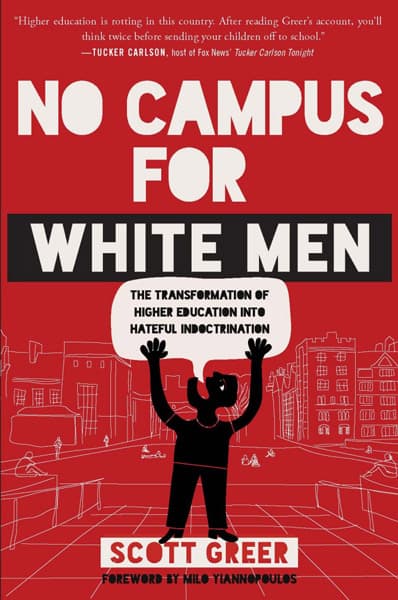My Long Journey from Liberalism to White Identity
Illian Veilleux, American Renaissance, April 24, 2021
This is part of our continuing series of accounts by readers of how they shed the illusions of liberalism and became race realists.
Growing up in the late 1990s and 2000s, my teachers always said that my peers and I were going to be “the generation that officially kills racism.” We were sold a fantasy of a post-racial world of joined hands and progress. As a kid, I remember growing up so optimistic for that future and wondering what part I’d get to play in it. What young soul wouldn’t want to be a part of that dream? My white classmates and I were ready and eager for this new dawn — willing to happily be the first to extend a hand of friendship to anyone from any culture, creed, or race.
I didn’t start out so eager, however. As a toddler, I saw footage on television of the 1992 Los Angeles Riots. My first exposure to blacks came from watching them destroy a city — groups of black men roving around in clusters, smashing, looting, setting fires, all while assaulting anyone who got in their way. Images of trashy streets with dilapidated homes, violence, and roaring fires were what I associated them with. When I started kindergarten and met a black person for the first time, I froze up. It was the day we’d all been asked to bring a board game from home so we could play it with our new classmates and make friends. My teacher paired me with two black kids. I looked at them and my mind jumped to the riots I’d seen on TV, and I said, “I don’t want them to light my game on fire.” Our teacher was disgusted. She took the game from my hands and gave it to the black kids, then sent me to the corner for a time-out. Then she lectured me on how I shouldn’t ever judge a book by its cover. At least half the class stopped what they were doing and watched. It was the most embarrassing thing that had ever happened to me, and I felt ashamed.
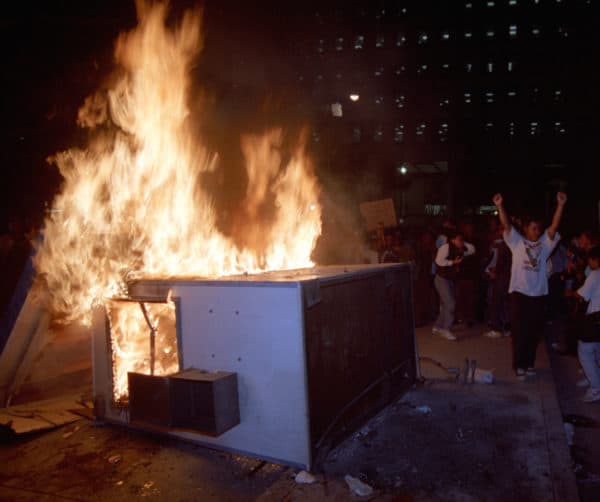
April 29 – May 4 1992 The Los Angeles riots. (Credit Image: © Gene Blevins/ZUMA Wire)
After that, I vowed never to judge someone before I actually got to know them. That vow (“don’t judge”) put racial blinders on me, it kept me from seeing what was happening all around me as I struggled to gain racial consciousness. The future post-racial society that was continually preached about in every grade only hardened my resolve to stay blind, to ignore pattern recognition.
My elementary, middle, and high school life wasn’t turbulent with racial divide or clashes. Only now can I recognize how fortunate I was to attend majority white schools. I had friends of every race, though my closest friends were always white. But when I met white kids who went to majority non-white high schools, I heard about the hate they experienced daily. They told me of hellish school lives forged along racial lines, with the fear of getting pummeled every single day by blacks or Hispanics. I’d wonder if maybe I too should be cautious around non-whites, but I’d always think back to my kindergarten incident, that “don’t judge” lesson, and ignore the thought.
As liberal and “anti-racist” as my schools had been from kindergarten through high school, it was nothing compared to the college I attended. The colorblind utopian worldview I had grown up with was replaced with a more explicitly anti-white ideology. One where the racial identity and cultural heritage of every people was celebrated — except for whites, whose identity and legacy was viewed as only one big unmitigated evil. The blacks I met in college weren’t like the ones I’d known in grade school. These ones were extremely vocal about race and politics, as if it was all they ever thought about. They were aggressive, too, often confronting professors and other students over the slightest perceived racial bias or micro-aggression towards them and their “fellow black folk.” At times, the issues they raised seemed overblown to me. But, as a liberal and a friend, I always listened to their perspectives and tried to be supportive.
Eventually, one of these black students, “Nia,” had a confrontation with a college administrator that ended with her being escorted off campus and expelled. She then filed a racial discrimination lawsuit. Never questioning her actions, I helped her with her case behind the scenes: searching for legal representation, typing out her version of the story and her rebuttals, etc. I was happy to help Nia, but I did tell her that I didn’t want to get so involved that I might risk my good standing with the college administration — after all, I was still a student there. I later learned that Nia resented me for saying as much.
Nia and I stayed in touch after I graduated, but our friendship became one-sided. I supported her through all her endeavors and struggles — emotionally, and at times financially — but she never did the same for me. Whenever we talked, she’d bring up my white skin and turned whatever issues I was working through into a “lesson” about “privilege,” — always delivered via condescending diatribe. I finally grew tired of the verbal bludgeoning that every conversation turned into, and severed ties with her. She responded by calling me a racist, among other things. My first “white sin” against her was that I’d been unwilling to risk losing my education by openly standing beside her in her crusade against our former college. She refused to recognize the ways in which I helped her over the years. Our final conversation left me feeling hungover, to put it mildly, but it was eye-opening.
The black students I knew in college, and how my relationship with them soured, gave me some of my first doubts about the liberal clichés about race I constantly heard. So did one incident off-campus my sophomore year. I had taken a train to visit my family during a holiday. Naïvely, I’d thought nothing of the fact that I’d pull into the station after 10 PM in a notoriously violent black ghetto. My car was still in the parking lot from an earlier visit, and as I loaded my bags into the trunk, a black man came charging at me from the shadows. His face looked crazed and menacing and he was yelling at me. I was pretty sure I saw the outline of a handgun in the pouch of his hoodie. I jumped into my car and tried to drive away, but he blocked my path, slamming his fist on my car, demanding that I give him some cash. I grabbed some scraps of paper and threw them out the window, yelling, “Two hundred bucks, it’s all I’ve got!” Luckily, the wind carried the “money” away from my car and he chased after it. The entire drive home, I thought about how if he had been friendly, I might have actually helped him. I felt stupid for having planned my arrival the way I did. I also thought about how I didn’t want to be a bigot, but I kept imagining myself lying dead in that parking lot or bleeding out in the back of an ambulance.
As much as that experience made me rethink my worldview, it was nothing compared to what happened when I moved to Baltimore. First, let me say directly to my readers: Avoid Baltimore. Don’t get off I-695 or I-95 into the city. Delicious steamed crabs and crab cakes are aplenty in just about any other part of the Chesapeake.
I was still a leftist when I arrived in Baltimore, and thought the warnings I’d heard about the city were nothing but examples of “backwards thinking.” I didn’t hold that opinion for very long. My first job had me traveling through the worst parts of the city several times a week. When I first saw the ruins known as “West Baltimore,” I couldn’t believe my eyes. “How can anybody live like this!?” I asked myself every time I ventured into the mess. Driving around West Baltimore or any neighborhood west of Martin Luther King Boulevard is an experience that photos or words can’t fully convey — not that I recommend seeing it firsthand. At first, you wonder how any city could degrade so completely. Boarded-up, rodent infested buildings sit next to still-standing burnt out structures. Rowhomes missing windows and roofs have trees and vegetation growing inside of them that spills out onto the street. Squalor and liquor stores are everywhere. Garbage filled alleyway after garbage filled alleyway. Nearly every street corner has black men whose job seems to be staring you down or a squeegee kid sizing you up. One hunched over, old black woman defiantly sweeping the crumbling steps of her rundown church. On the adjacent lot, a group of twenty or so black men watch her while sipping 40-ounce bottles of malt liquor at 10 AM. As one of Baltimore’s former black mayors once put it, “Whoa, you can smell the rats!” Soon you’re just trying to figure out how to get out of there. I ran more than one stoplight doing exactly that, and was never once pulled over. The cops are too busy with all the murders and shootings.
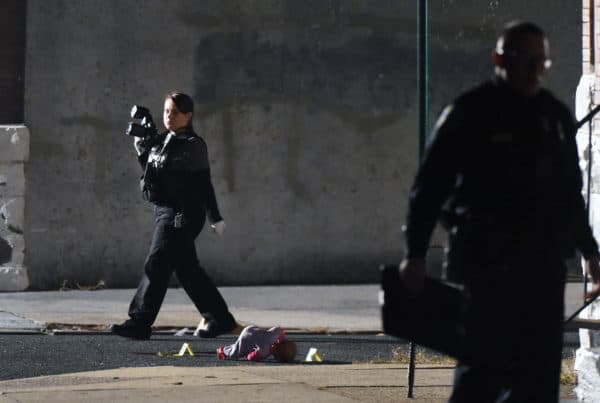
Baltimore City Police officers investigate the scene of a shooting on the 1000 block of McKean Avenue, where a 5-year-old was shot, on Monday, Nov. 19, 2018. On the ground appears is a child’s doll laying next to police shooting tags. (Credit Image: © Kenneth K. Lam / Baltimore Sun / TNS via ZUMA Wire)
I turned to coworkers and friends who grew up in Baltimore to get some explanations for the ruin and decay. “Racism, no opportunities, poverty, resource-hoarding (evil) whites, home redlining, food deserts, liquor stores on every corner” were the usual answers I got. On occasion, I’d hear “corrupt leadership,” but it was framed in the context of some secretive white clique “keeping the black man down.” At first these answers, and their variations, seemed plausible, but with time, they sounded more and more like excuses. I started paying close attention to politics on the local, state, and national levels, especially keeping an eye on the city’s never-ending crime wave. Looking into crime statistics led to a big discovery: Blacks commit the vast majority of violent crime, not just in Baltimore, but everywhere. I started noticing other patterns, too. When I volunteered with “clean up the city” efforts, my volunteer groups were always majority white. The same was true of the attendees at “community growth” meetings focused on citywide change. I began to wonder if most black people simply didn’t care about their city. The more I researched and read, the more my leftist views started to evaporate. The more I worked in West Baltimore, the more my “don’t judge” pledge from childhood receded into the back of my mind. “Never relax” became my new slogan when around non-whites.
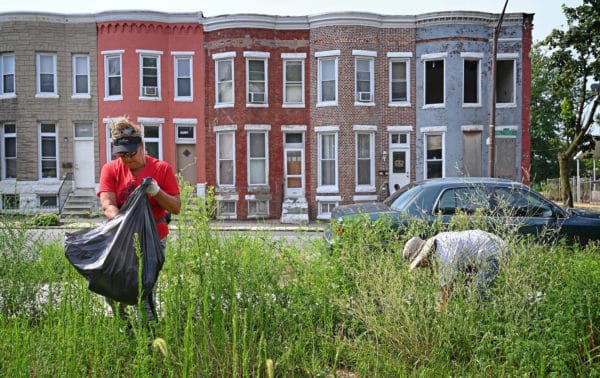
Jonna Comstock, of Culpepper, Va., picks up trash in a vacant lot along Westwood Avenue in Baltimore. (Credit Image: © TNS via ZUMA Wire)
After Baltimore’s Freddie Gray Riot in 2015, I lost all hope that whites and blacks could co-exist peacefully in a civilized society. I’ll never forget watching the city burn as the black mayor stirred the pot on local television by calling the rioters “thugs,” but simultaneously asking that they be given “space.” Allowing the rioters to vent their racial angst took top priority. I thought about how I was watching the same scenes I’d seen on TV as a toddler, just in a different city. The post-racial, utopian dream serenaded to me throughout my childhood was total folly. When I tuned into social media, I discovered the same non-whites I had been friends with while growing up in grade school were cheering on the chaos, calling for more “social justice reform,” Critical Race Theory, and racial sensitivity training. They had fully embraced their “victimhood” status and were proud of the madness happening around my city while the local government handled the situation with kid gloves. Later on, I found out that a few white people I knew personally had lost their cars or other property in the riot’s fires. Some of them, leftists, shrugged and made excuses for the perpetrators: “These poor blacks never had a chance in life,” they’d say, as if that gave criminals a blank check to literally run riot. Even people whose lives were made worse by the rioting maintained that somehow, the real problem was subconscious white racism and police bias.
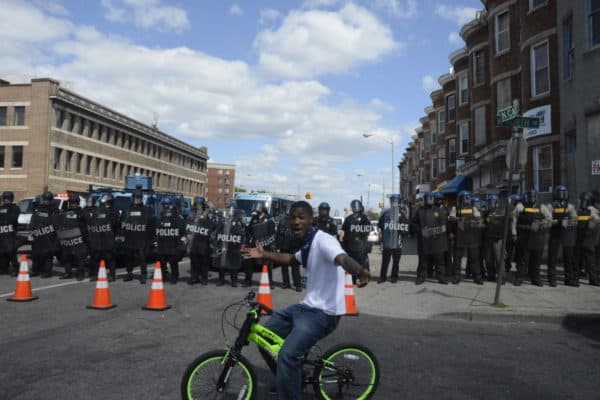
April 29, 2015 – Baltimore, Maryland – Police stand in formation in Baltimore, which is under curfew following riots. (Credit Image: © Xinhua via ZUMA Wire)
Still, I didn’t want to consider that racial differences might actually be real. When the thought seeped into my mind, I tried to ignore it. But eventually, I caved and decided to research the matter, even though doing so made me feel guilty. It felt like a betrayal of myself — a loss of innocence — an abandonment of ideals I had held with the best of intentions. Trying to learn more about the biology of race led me to alternative news sites, and eventually, American Renaissance and Jared Taylor. The rest, as they say, is history. The writing, research, and content produced by Mr. Taylor and the writers at AmRen are invaluable, and give me hope. As I’ve continued to study, read, and grow over these last few years, I no longer feel any shame in being proud of my race and its achievements.
I’m still in Baltimore, for now. In some ways it has gotten worse since I first arrived. Since 2018, my neighborhood has been flooded with Hispanic immigrants. More than two years have passed, and they still dump their trash into the street instead of handling it properly. It only takes a few hours worth of wind for it to travel all over the place, including my yard. The music from their fiestas wakes me up in the middle of the night, and when I look out my rattling windows I can see that many party-goers have parked their trucks all over my lawn. Attempts to talk to them about any of this are met with, “F-ck you, gringo.” Complaints to code enforcement go nowhere, and the police are too busy investigating rampant black-on-black murder to handle neighborhood disputes. But according to the news and everywhere else I look, these Guatemalans are “enriching” my racist, white life. I’m counting down the days until I can get out of this cesspool for good.
If you have a story about how you became racially aware, we’d like to hear it. If it is well written and compelling, we will publish it. Use a pen name, stay under 1,200 words, and send it to us here.

